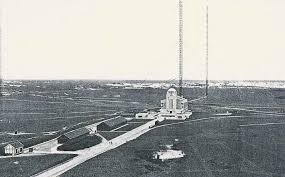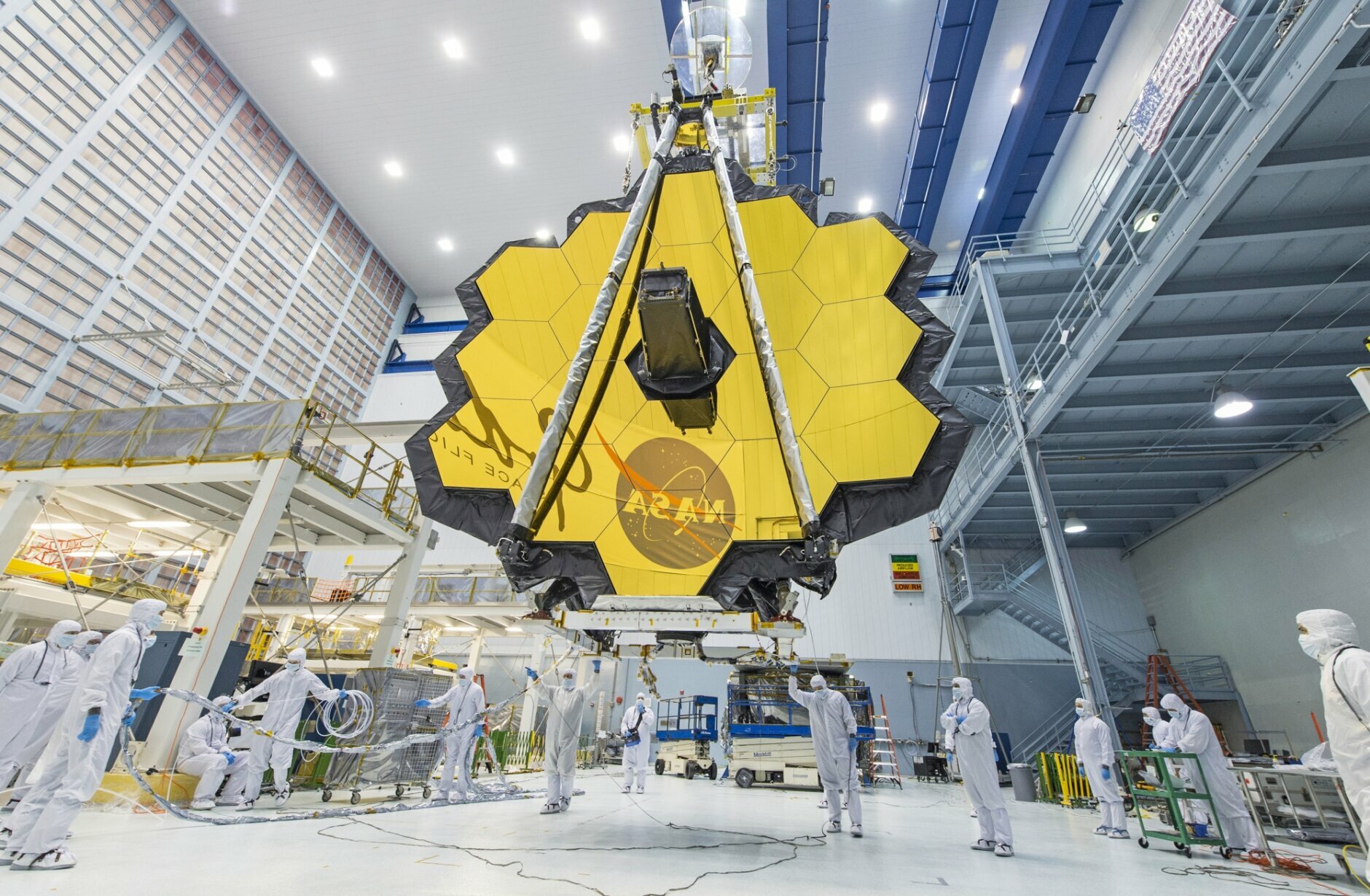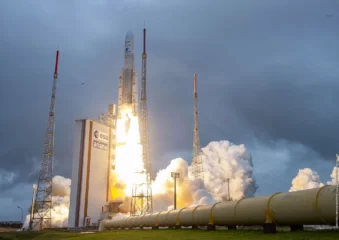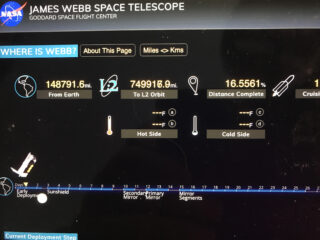
James Webb Space Telescope Launch 2021. 13:20zaterdag 25 December
How to Watch the James Webb Space Telescope Launch
Astronomers have been waiting eagerly for the beginning of the powerful space observatory’s mission, and on Christmas morning they may finally get their wish.
LAATSTE NEWS OVER DE TE VERRICHTEN DEPOYMENTS/ DE JAMES WEBB TELESCOPE HEEFT AUTONOOM DE TWEEDE KOERSCORRECTIE AFGEROND.
https://jwst.nasa.gov/En dat brengt de ruimtetelescoop beter op koers richting zijn eindbestemming: een plek nabij het zogeheten tweede Lagrangepunt.
De machtige James Webb-telescoop is enkele dagen geleden begonnen aan zijn lange reis naar lagrangepunt 2; een virtueel punt in de ruimte op ongeveer 1,5 miljoen kilometer afstand van de aarde. Om hier te komen moet de telescoop echter wel enkele cruciale manoeuvres uitvoeren. En onlangs heeft James Webb de tweede koerscorrectie succesvol voltooid.
Lagrangepunt 2
Zoals gezegd stevent James Webb af op een plek nabij het zogeheten tweede Lagrangepunt. Op dit tweede Lagrangepunt zijn de zwaartekrachten tussen de aarde en de zon in evenwicht, waardoor de telescoop in een stabiele positie blijft en op lange termijn vrijwel onbelemmerd zicht heeft op de nachtelijke hemel. Bovendien is kalibratie van en communicatie met het ruimteobservatorium in L2 eenvoudiger. Een ruimtegerichte observatiesatelliet op dit punt heeft daarnaast altijd de zon, de aarde en de maan achter zich. Hierdoor is afscherming makkelijker en kunnen waarnemingen rond de klok doorgaan.
Ietsje verderop
De plek waar James Webb op afstevent, bevindt zich overigens niet precies op L2, maar ietsje verderop. De telescoop zal opereren vanuit een losse baan – vele honderdduizenden kilometers in diameter – rond L2. Hier baadt James Webb namelijk in constant in zonlicht en is er nog betere communicatie tussen James Webb en de aarde mogelijk. https://1c7b9d5abc5701663b434c50563cdd88.safeframe.googlesyndication.com/safeframe/1-0-38/html/container.html
De precieze plek waar vandaan de James Webb-telescoop de nachtelijke hemel zal gaan bestuderen. Afbeelding: NASA
In totaal staan er drie koerscorrecties op het programma: MCC-1a, MCC-1b en MCC-2. De eerste – en de belangrijkste – van de drie voerde de James Webb-telescoop al vrij kort, ongeveer twaalf uur, na zijn lancering uit. Tijdens deze 65 minuten durende manoeuvre, werd de telescoop op het juiste pad gebracht om het beoogde Lagrangepunt binnen dertig dagen te kunnen bereiken. Eventuele afwijkingen in het traject veroorzaakt door de lancering, werden dankzij deze koerscorrectie gecorrigeerd.
Tweede koerscorrectie
Het team komt nu wederom met heugelijk nieuws. Want James Webb heeft onlangs ook zijn tweede koerscorrectie succesvol voltooid. De telescoop voerde MCC-1b zestig uur na zijn lancering uit. De koerscorrectie duurde 9 minuten en 27 seconden; iets korter dan MCC-1a. Dankzij deze manoeuvre verfijnt de telescoop zijn pad naar L2.
Derde koerscorrectie
James Webb zal de komende tijd op zijn eindbestemming blijven afstevenen. Ondertussen zullen steeds meer onderdelen waar de telescoop mee uitgerust is, worden uitgevouwen. De laatste koerscorrectie, MCC-2, zal vervolgens net voordat James Webb op L2 arriveert, worden uitgevoerd. Vooralsnog staat deze laatste manoeuvre gepland voor 29 dagen na lancering, al is het precieze moment niet tijdkritiek. En dan kunnen de observaties bijna beginnen…Benieuwd waar de telescoop op dit moment uithangt? Op deze pagina kun je precies volgen waar James Webb is en wanneer er weer onderdelen uitgeklapt gaan worden.
Overigens zullen we nog wel even geduld moeten hebben voordat de telescoop met zijn eerste ontdekkingen op de proppen komt. Wanneer de telescoop op zijn beoogde orbitale locatie aankomt, volgt er eerst een acclimatisatie-periode van zes maanden. In deze maanden bereidt James Webb zich voor op zijn komende taken. Het betekent dat het nog wel even gaat duren voordat James Webb daadwerkelijk operationeel is. Onderzoekers zullen vanaf de grond de telescoop nauwgezet in de gaten blijven houden. En als James Webb er helemaal klaar voor is, kunnen de wetenschappelijke observaties na een halfjaar van start gaan. Populaire artikelen op Scientias.nl Gigantisch langhuis van de Vikingen ontdekt in Noorwegen Lancering van James Webb-ruimtetelescoop nog één keertje uitgesteld Eindelijk is het zo ver: de langverwachte lancering van de James Webb-telescoop is aanstaande Het ontvouwen van de machtige James Webb-telescoop is in volle gang De bloedarend, een misselijkmakende executiemethode van de Vikingen, was anatomisch mogelijk Aliens hebben mogelijk eigenhandig een leefbaar plekje in de wolken van Venus geknutseld Lancering van James Webb-telescoop een dagje uitgesteld Perfect bewaard gebleven embryo van een dinosaurus ontdekt .
Bronmateriaal:
“Webb’s Second Mid-Course Correction Burn” – NASA
Afbeelding bovenaan dit artikel: NASA GSFC/CIL/Adriana Manrique Gutierrez
Fout melden
Meld een spelfout of feitelijke onjuistheid.
Blijf je verwonderen ✨
Ontvang iedere vrijdag de mooiste ruimtefoto’s en interessante populair-wetenschappelijke artikelen. Ontvang samen met 50.000 anderen het gratis Scientias Magazine.
Mummie van farao Amenhotep I voor het eerst (digitaal) uitgepakt Exotische vondst tijdens opgravingen in Enkhuizen: een schildpad uit de 17e eeuw
Voor de wereld van morgen
- Van bestelbus tot duurzaam huis op wielen
- Goals: Braziliaans echtpaar plant 2.7 miljoen bomen
- Rewilding laat de natuur zichzelf herstellen
Een community van
Volg ons
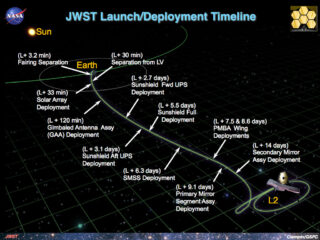
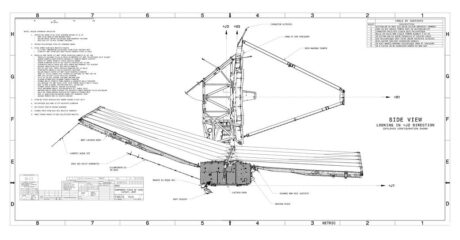
JAMES WEBB TELESCOPE MISSION
NASA’s Webb Telescope Launches to See First Galaxies, Distant Worlds
Editor’s note: This release was updated on Dec. 25 to reflect the observatory’s release at approximately 870 miles (1,400 kilometers).
NASA’s James Webb Space Telescope launched at 7:20 a.m. EST Saturday on an Ariane 5 rocket from Europe’s Spaceport in French Guiana, South America.
A joint effort with ESA (European Space Agency) and the Canadian Space Agency, the Webb observatory is NASA’s revolutionary flagship mission to seek the light from the first galaxies in the early universe and to explore our own solar system, as well as planets orbiting other stars, called exoplanets.

NASA’s James Webb Space Telescope launched Dec. 25 at 7:20 a.m. EST on an Ariane 5 rocket from Europe’s Spaceport in French Guiana, on the northeastern coast of South America. Webb, a partnership with the European Space Agency and the Canadian Space Agency, will explore every phase of cosmic history – from within our solar system to the most distant observable galaxies in the early universe. Credits: NASA/Bill Ingalls
“The James Webb Space Telescope represents the ambition that NASA and our partners maintain to propel us forward into the future,” said NASA Administrator Bill Nelson. “The promise of Webb is not what we know we will discover; it’s what we don’t yet understand or can’t yet fathom about our universe. I can’t wait to see what it uncovers!”
Ground teams began receiving telemetry data from Webb about five minutes after launch. The Arianespace Ariane 5 rocket performed as expected, separating from the observatory 27 minutes into the flight. The observatory was released at an altitude of approximately 870 miles (1,400 kilometers). Approximately 30 minutes after launch, Webb unfolded its solar array, and mission managers confirmed that the solar array was providing power to the observatory. After solar array deployment, mission operators will establish a communications link with the observatory via the Malindi ground station in Kenya, and ground control at the Space Telescope Science Institute in Baltimore will send the first commands to the spacecraft.
Engineers and ground controllers will conduct the first of three mid-course correction burns about 12 hours and 30 minutes after launch, firing Webb’s thrusters to maneuver the spacecraft on an optimal trajectory toward its destination in orbit about 1 million miles from Earth.
“I want to congratulate the team on this incredible achievement – Webb’s launch marks a significant moment not only for NASA, but for thousands of people worldwide who dedicated their time and talent to this mission over the years,” said Thomas Zurbuchen, associate administrator for the Science Mission Directorate at NASA Headquarters in Washington. “Webb’s scientific promise is now closer than it ever has been. We are poised on the edge of a truly exciting time of discovery, of things we’ve never before seen or imagined.”
The world’s largest and most complex space science observatory will now begin six months of commissioning in space. At the end of commissioning, Webb will deliver its first images. Webb carries four state-of-the-art science instruments with highly sensitive infrared detectors of unprecedented resolution. Webb will study infrared light from celestial objects with much greater clarity than ever before. The premier mission is the scientific successor to NASA’s iconic Hubble and Spitzer space telescopes, built to complement and further the scientific discoveries of these and other missions.
“The launch of the Webb Space Telescope is a pivotal moment – this is just the beginning for the Webb mission,” said Gregory L. Robinson, Webb’s program director at NASA Headquarters. “Now we will watch Webb’s highly anticipated and critical 29 days on the edge. When the spacecraft unfurls in space, Webb will undergo the most difficult and complex deployment sequence ever attempted in space. Once commissioning is complete, we will see awe-inspiring images that will capture our imagination.”
The telescope’s revolutionary technology will explore every phase of cosmic history – from within our solar system to the most distant observable galaxies in the early universe, to everything in between. Webb will reveal new and unexpected discoveries and help humanity understand the origins of the universe and our place in it.
NASA Headquarters oversees the mission for the agency’s Science Mission Directorate. NASA’s Goddard Space Flight Center in Greenbelt, Maryland, manages Webb for the agency and oversees work on the mission performed by the Space Telescope Science Institute, Northrop Grumman, and other mission partners. In addition to Goddard, several NASA centers contributed to the project, including the agency’s Johnson Space Center in Houston, Jet Propulsion Laboratory in Southern California, Marshall Space Flight Center in Huntsville, Alabama, Ames Research Center in California’s Silicon Valley, and others.
For more information about the Webb mission, visit:
